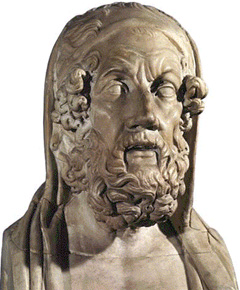
Epicurus was born in 341 B.C. and died in 270 B.C. He founded one of the major philosophies of ancient Greece, helping to lay foundations for modern science and also for secular individualism. Many of his aspects are still relevant today. His philosophy was based on materialism and moderation of desires and cultivation of friendships. It was based on humanistic ideas and materialistic ideas based around rational thinking. Epicurus thought that both mind and matter were conglomerations of material elements.He believed that in a society that could punish impiety towards its gods with death that it did not deny their existence but simply points out that the qualities were given to them in an indifference to humanity. From Epicurus' ideas, he opened up a school to many people (including slaves) who couldn't gain access to the worldly philosophers. It was also for the wealthy, powerful, and educated, it was opened for all.
Epicurus’ teachings had a major effect on the Hellenistic world. At the age of 35, Epicurus settled in Athens and founded a Garden, which was a place at that time where his followers could gather and be taught. He taught that desires in life can be painful so you should only desire what you can get. Epicurus also taught that the gods should not be feared because they were not interested and not involved in human affairs,and that death should not be feared. These teaching were inconsistent with Christianity. The strength of his philosophy was that he told many people that weakness leads to an opportunity to desire strength and a person should eliminate all these desires. Epicurus' philosophy taught that pain was nothing compared to pleasure, and that actual moments of pain do not go by quickly.
Epicurus followed the materialist philosopher Democritus, in believing that the world was composed of atoms and that those making up each person dissolved when that person died. All that could be known must be based on observation and experience of this world. He taught that the only purpose of this life was to ensure survival in the world through pleasure of things. By this he did not mean a search for enjoyment but instead a peace of mind and freedom from pain. To achieve this it was important to not fear death and to concentrate on the pleasures of life from which he considered friendship and rational thinking. Epicureanism was never fully respectable but it proved to be popular in the last few years of republican Rome and it still today has not lost its impact. ( Freeman 351 book 1 )
Epicureans had an important influence on Christianity, though some of it was inconsistent with it. The Christian idea that holy people should separate themselves from the world, and not to think about themselves or about the things they own or on their friends and family but to focus on Heaven and its gifts. From this we owe something to Epicureanism. But Christians hated Epicureanism because it denied the existence of heaven and hell, and for their reliance on pleasure as a way of life. So Epicureanism became less popular partly because of the rise of Christianity. If Epicurus had fully eradicated faith in his time, today we would most likely be living in a completely secular culture today. But faith lived on. Within Epicurus’ influence the atheistic moral philosophy freely developed. His moral emphasis “focused upon the individual and his immediate desires for pleasures instead of upon abstract principles of what God wants. He thought of that pleasure and pain had no distinguished difference.
When the Hellenistic Age started the Greeks concentrated on achievement. Epicurus believed that random nature of the collisions ensured that life would be predictable. Except life is not always predictable only in some ways. He also believed that there was need to fear the gods but he did believe in them and their powers. The Garden was a place where people could celebrate birthdays, the writing of elaborate poems on relationships, and sharing of life. ( Freeman 362 and 363 book 2 )
Freeman, Charles. The Greek Achievement. New York: Penguin Putnam, Inc, 1999 ( book 1 )
Freeman, Charles. Civilizations of the Ancient Mediterranean. New York: Oxford University Press, Inc, 2004 ( book 2 )









